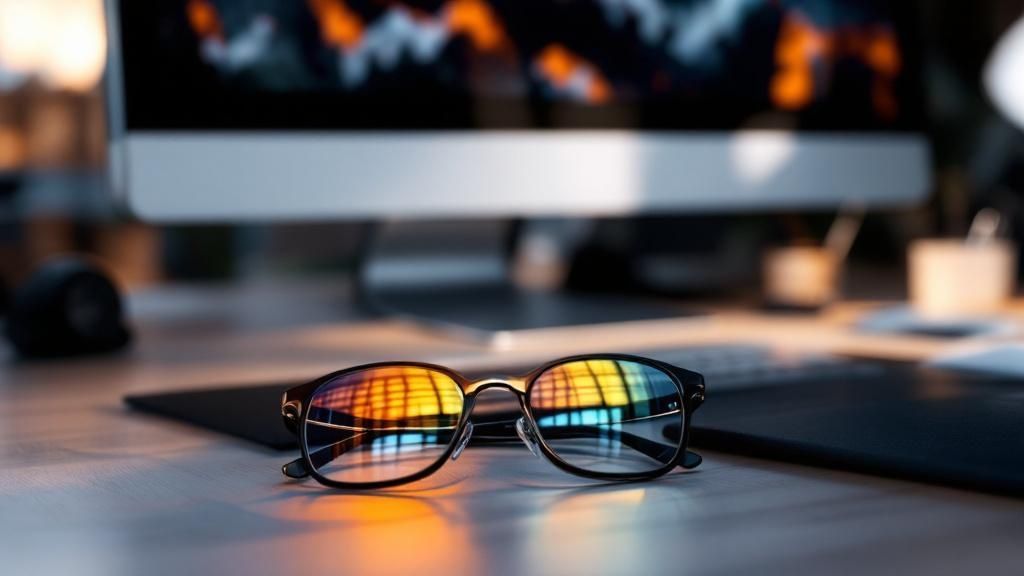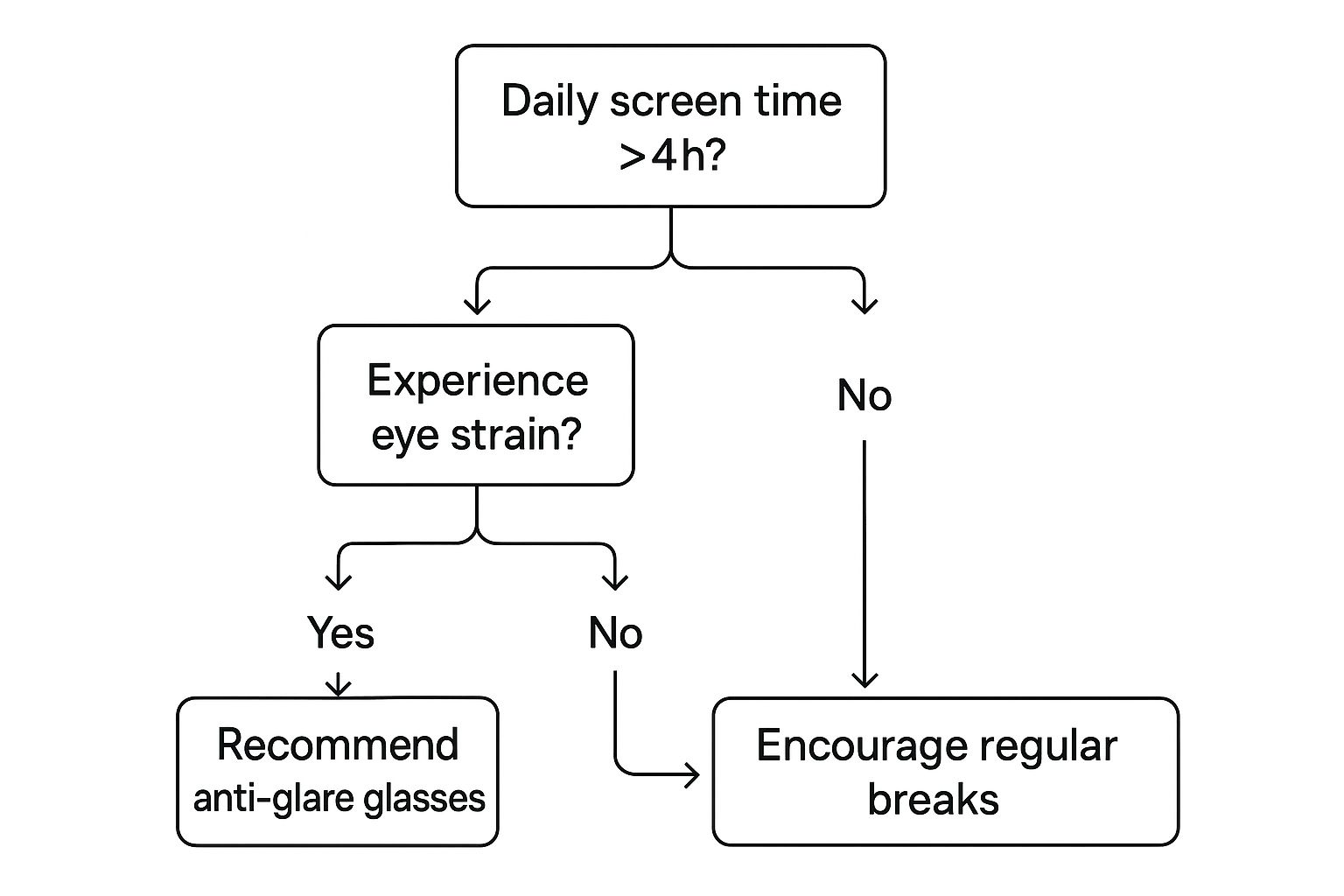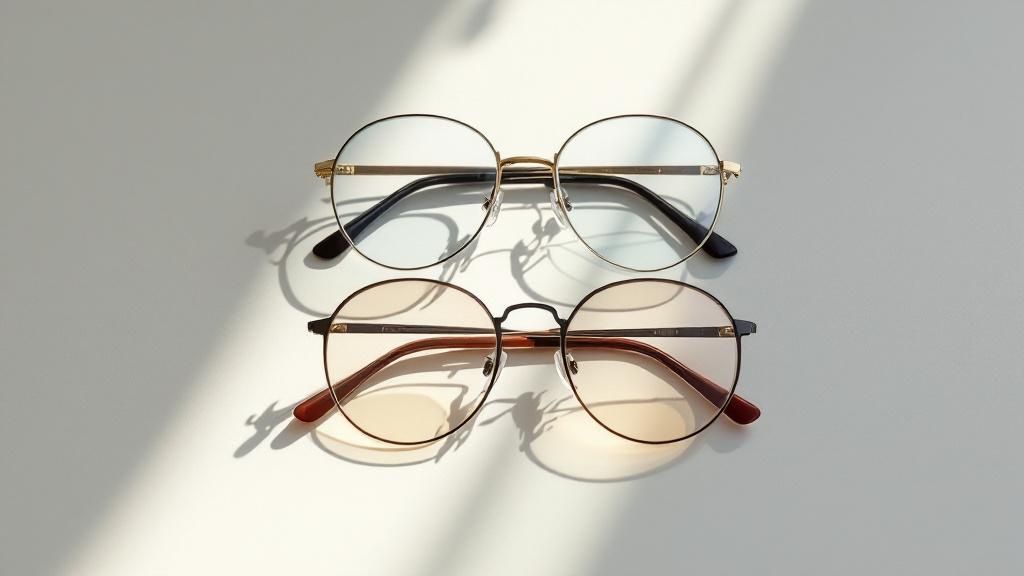
Anti Computer Glare Glasses for Digital Eye Strain
You've probably felt it—that familiar, gritty sensation in your eyes after a long day glued to a screen. It’s the dull headache that starts creeping in around 3 PM or the blurry text that makes you squint. This isn't just you; it's a collection of symptoms often called digital eye strain or computer vision syndrome, and it’s become an unwelcome side effect of our very digital lives.
Tired Eyes After a Long Day of Screen Time

So, what’s actually happening here? A lot of the time, the culprit is the relentless glare bouncing off our monitors, tablets, and phones. This harsh, unfocused light acts like "visual noise," forcing the tiny muscles in our eyes to work overtime just to stay focused. All that extra effort leads directly to fatigue, discomfort, and that all-too-familiar tired feeling.
Enter anti computer glare glasses. These aren't just another gadget. Think of them as a simple, practical tool for making your day-to-day life more comfortable. They work by using a special anti-reflective (AR) coating on the lenses that acts like a shield, cutting down on the distracting reflections from your screen and even the overhead lights in your office. The result is a crisper, clearer view that lets your eyes relax.
Who Are These Glasses For?
Honestly, they're for anyone who spends a good chunk of their day staring at a screen. You don't need a prescription to benefit. This includes people like:
- Office Professionals: You know, the ones staring down spreadsheets and emails for eight or more hours a day.
- Students and Educators: Anyone who relies on online learning platforms and digital textbooks.
- Gamers and Designers: People who need intense visual focus on bright, detailed screens for hours on end.
- Casual Users: Even just scrolling through social media or watching movies on your laptop at night adds up.
By filtering out the visual static of screen glare, these glasses allow your eyes to focus more naturally and with much less effort. It's a straightforward fix that directly tackles one of the biggest causes of digital eye strain.
To give you a better idea of what to expect, here's a quick rundown of the immediate benefits.
Quick Benefits of Anti-Glare Computer Glasses
| Benefit | How It Helps You |
|---|---|
| Reduces Eye Strain | Minimizes the harsh light that forces your eye muscles to work overtime. |
| Improves Visual Clarity | By cutting glare, text and images on your screen appear sharper and more defined. |
| Lessens Headaches | Easing eye muscle tension often helps prevent strain-related headaches. |
| Enhances Focus | With fewer distractions from reflections, you can concentrate on your tasks for longer. |
Ultimately, adding a pair of anti-glare glasses to your desk setup is a small change that can make a huge difference in how you feel at the end of the day.
While glasses are a fantastic preventative measure, if your eyes are already feeling the strain, other soothing options like a Phytomer Eye Perfection treatment can offer some much-needed relief. In the long run, though, being proactive with the right eyewear is a powerful step toward making peace with our screens.
How Anti Computer Glare Glasses Actually Work
To get a feel for how anti-computer glare glasses do their job, think about a normal window on a really bright, sunny day. You can see what's outside, sure, but you also get a ton of distracting reflections—your own face, the room behind you, the clouds in the sky. Now, what if that same window had some kind of invisible layer that just made all those reflections disappear, giving you a perfectly clear, crisp view?
That’s pretty much the principle behind the technology in these glasses. The real magic is an incredibly thin anti-reflective (AR) coating that's applied to the lenses. It's not just one layer, but a series of microscopic films, each one precisely engineered to manage how light waves behave.
The Science of Canceling Reflections
When light from your monitor or overhead lights hits a standard, uncoated lens, a good chunk of it bounces right back off the surface. That reflection is what we perceive as glare, and it's the visual "static" that makes our eyes work overtime and feel strained.
An AR coating tackles this head-on using a process called destructive interference.
It's a lot like how noise-canceling headphones work. Those headphones listen to the ambient noise around you and then create an opposite sound wave to cancel it out. In the same way, the layers in an AR coating are meticulously designed to create "anti-light" waves that effectively neutralize the light waves reflecting off your lenses. This allows more than 99% of the good, useful light to pass straight through to your eyes, giving you a much sharper and clearer picture.
The goal of an anti-reflective coating is simple but powerful: maximize the light that reaches your eye for clear vision while minimizing the light that bounces off the lens as distracting glare. This improves both comfort and visual acuity.
It's also really important to know the difference between two terms that people often use as if they mean the same thing. You can dive deeper into the specifics in our complete guide to anti-glare glasses for computer use.
Anti-Glare vs. Anti-Reflective Coatings
Even though they sound almost identical, their approaches to handling light are worlds apart. Nailing down this difference is key to picking computer glasses that will actually help.
- Anti-Glare (Matte Finish): This is a simpler, more basic technology. It works by creating a slightly rougher, or matte, surface on the lens. Instead of reflecting light in one focused beam, it scatters the light in all different directions. While this does tone down the harshness of a direct reflection, it can also subtly reduce visual sharpness—not exactly what you want when you're trying to read fine text on a screen for hours.
- Anti-Reflective (AR Coating): This is the more sophisticated technology you'll find in high-quality computer glasses. It doesn't just scatter light; it actively cancels out the reflections. This gives you the absolute best clarity and is the superior option for fighting digital eye strain, as it delivers a crisper, more defined image with zero visual fuzz.
For anyone who puts in serious hours in front of a screen, an AR coating isn't just a nice-to-have, it's essential. It gets right to the root cause of glare-induced eye fatigue by clearing away all that visual static. This lets your eyes focus on what's on the screen, not fight against it, making these modern glasses a vital tool for digital life.
The Science of Reducing Digital Eye Strain

The tech that goes into anti-glare coatings is impressive, but its real value is in how it tackles the physical toll of all that screen time. If you've ever finished a long day at your desk with a throbbing headache, blurred vision, or dry, scratchy eyes, you've met Computer Vision Syndrome (CVS). It isn't just one problem, but a whole host of issues that stem from how our eyes struggle with digital displays.
A huge part of this is the constant, tiny adjustments your eye muscles make to fight screen glare. Picture your focusing muscles stuck on high alert, always flexing to cut through the visual "noise" bouncing off your screen. Just like holding a dumbbell for too long wears out your arm, this non-stop effort leads directly to muscle fatigue. Anti-glare coatings simply cut out that noise, letting your eye muscles relax and focus the way they're supposed to.
The Impact of High-Energy Visible Light
But glare is only half the battle. Modern screens throw another challenge at us: blue light. This slice of the light spectrum, officially known as high-energy visible (HEV) light, is blasted out by the LEDs in our phones, tablets, and monitors. We get a dose from sunlight, of course, but our up-close-and-personal, all-day exposure from devices is a totally new thing for our eyes.
This is exactly why so many anti computer glare glasses now have blue light filtering built right in. By blocking a specific percentage of these high-energy waves, these specialized lenses add another crucial layer of protection against that all-too-familiar visual fatigue.
The dual action of fighting both glare and blue light is what makes modern computer glasses so effective. They address two distinct sources of eye strain, providing a more complete solution for screen-heavy lifestyles.
The perks go way beyond just feeling better at the end of the workday. Getting a handle on your blue light exposure, especially in the evening, is key to maintaining a healthy sleep-wake cycle. Blue light is known to interfere with the production of melatonin, the hormone that tells your body it’s time to wind down.
Connecting Comfort to Wellness
By filtering this light, computer glasses can help you ease into sleep more naturally, which leads to better rest and sharper focus the next day. This makes them a tool not just for eye comfort but for your overall well-being. Getting a grip on these factors is critical; for more hands-on advice, take a look at our guide on how to reduce eye strain from computer use.
People are definitely catching on. The growing awareness of these issues has kicked off a major surge in demand for protective eyewear. Market reports are showing that with screen time on the rise for everyone, the global market for anti-glare glasses is booming, with sales projected to hit several million units a year by 2033. This isn't just a fad; it’s a clear sign that we're all starting to take our visual health more seriously in our screen-filled world.
How to Choose the Right Anti-Glare Glasses
Okay, you're sold on the benefits. So, how do you actually pick the right pair? It’s not as complicated as it sounds. Forget the technical jargon—this is all about matching the right features to your daily life. A little bit of know-how will help you find the perfect pair that feels like it was made just for you.
First things first: do you need prescription lenses? Many people who have perfect vision still get a ton of relief from non-prescription, or "plano," computer glasses. If you already wear glasses for vision correction, you can simply have an anti-reflective coating added to your next pair to fight off that screen glare.
Evaluate Your Lens and Coating Needs
The quality of the anti-reflective (AR) coating is where the magic happens. A top-notch AR coating is what separates a truly effective pair of glasses from a mediocre one. In fact, this technology is a huge deal, with the market valued at around USD 6.23 billion in 2025 and expected to jump to USD 10.3 billion by 2032, all thanks to better lens tech.
Beyond the coating itself, you need to think about how much blue light filtering you need. This usually comes down to the color of the lens tint:
- Clear Lenses: These typically block a smaller amount of blue light (30-50%). They're perfect for designers, artists, or anyone who needs to see colors accurately. You get great glare reduction without distorting your view.
- Yellow-Tinted Lenses: Stepping it up a notch, these block a solid 50-70% of blue light. This makes them a fantastic all-around choice for general office work, as they enhance contrast and take the edge off eye strain.
- Amber or Red-Tinted Lenses: For the most intense protection, these lenses block up to 99% of blue light. They're a favorite among hardcore gamers and night owls working late, as they do a much better job of protecting your natural melatonin production for a good night's sleep.
This image offers a quick and easy way to see if anti-glare glasses are a good fit for you based on your daily screen time and symptoms.

As you can see, if you're spending a lot of time in front of a screen and feeling the effects, these glasses are a highly recommended solution.
Feature Comparison for Anti-Glare Glasses
To make it even clearer, this table breaks down which features are most important depending on how you use your screens. Use it as a quick guide to pinpoint what you should be looking for.
| Feature | Best For Casual Users | Best For Office Professionals | Best For Gamers/Designers |
|---|---|---|---|
| AR Coating | Standard quality is fine for reducing basic glare. | High-quality multi-layer coating is essential for all-day comfort. | Premium, multi-layer coating to eliminate all reflections. |
| Blue Light Filter | A low-level filter (30%) is sufficient for occasional use. | Mid-level tint (50-70%) to reduce strain without major color shift. | High-level tint (70-99%) for maximum protection during intense sessions. |
| Lens Tint | Clear or very light tint. | Light yellow tint to enhance contrast and ease eye fatigue. | Amber/red for gamers; Clear for designers needing color accuracy. |
| Frame Material | Basic plastic or metal is acceptable. | Lightweight materials like acetate or titanium for all-day wear. | Durable, lightweight, and comfortable for long hours of focus. |
This comparison should help you prioritize what matters most, whether you're just browsing the web or competing in an esports tournament.
Match Features to Your Lifestyle
Finally, let's talk about comfort and style. If you're going to be wearing these glasses for hours on end, they have to feel good. Lightweight frames that fit your face properly are a must. A poorly fitting pair will just trade one kind of discomfort for another, which completely defeats the purpose.
The best anti computer glare glasses are the ones you'll actually wear. Prioritizing a comfortable fit and a style you genuinely like is just as important as the lens technology itself.
Take a moment to think about your daily routine. Are you a programmer staring at lines of code? A student glued to online lectures? There's a perfect combination of features out there for you. For a more detailed breakdown, you can read our guide on choosing glasses for computer eye strain. By focusing on these key areas—prescription, coating, blue light filtering, and comfort—you'll be able to confidently pick the right eyewear to make your screen time a whole lot easier on your eyes.
Leading Brands and Real-World Examples

It’s one thing to talk about the science behind anti-glare computer glasses, but seeing that technology in action is what really makes the benefits click. The market is packed with options, but a few key brands rise to the top by delivering on their promises of quality lens tech and smart, wearable design.
The demand for this kind of eye protection is exploding. The global anti-glare glass market, worth about USD 2.95 billion in 2024, is projected to climb to roughly USD 4.74 billion by 2033. This isn't just a fleeting trend; it’s a direct response to our screen-centric lives and a growing awareness of how to combat digital eye strain.
A Closer Look at Spektrum Glasses
Spektrum Glasses is a fantastic example of a brand that gets it right. They've built their entire reputation on science-backed eyewear that actually works. Instead of a one-size-fits-all approach, they offer different lenses for different situations. Their Prospek line is a perfect showcase of this philosophy.

As you can see, you don't have to choose between function and style. Spektrum offers everything from classic to modern frames, so you can find something that fits your look. But it’s the details under the hood that really set them apart.
They nail the essentials for all-day comfort:
- Premium AR Coatings: Their lenses use multi-layer coatings to stamp out those distracting reflections from your screen and overhead lights, giving you a crystal-clear view.
- Targeted Blue Light Filtering: You can pick your level of protection. They offer 50% blocking for general daytime work and a powerful 99% filter for late-night screen use, letting you tailor the glasses to your daily rhythm.
- Durable and Lightweight Frames: If you’re wearing glasses for hours, they have to be comfortable. Spektrum uses quality materials to keep their frames light enough that you’ll probably forget you’re even wearing them.
What Other Brands Offer
While Spektrum is a heavyweight in the space, other great brands like Zenni Optical and Gunnar Optiks are also worth a look. Each brings a slightly different philosophy to the table. Gunnar Optiks, for instance, is a huge name in the gaming world, known for its signature amber-tinted lenses that boost contrast and aggressively block blue light.
The best brands don't just sell glasses; they offer a solution. They understand that a graphic designer needs perfect color accuracy, while a gamer needs maximum protection for a marathon session.
This variety is fantastic for us as consumers. It means you can find a pair that not only shields your eyes but also fits your unique lifestyle and personal style. By seeing how leading brands apply the principles of AR coatings and blue light filtering, you can better understand what to look for and make a smart investment in your own visual health.
How to Care for Your Anti-Glare Lenses
Your new anti-glare glasses are a fantastic tool for visual comfort, but that delicate anti-reflective (AR) coating needs a little TLC to keep working its magic. If you use the wrong cleaning methods, you can easily scratch the surface or even strip the coating right off, which completely defeats the purpose.
The single most important thing you can have is a clean microfiber cloth. These aren't just fancy dusters; they're specifically designed to grab onto oil, smudges, and dust without being abrasive. Paper towels, napkins, or the hem of your shirt might seem harmless, but they all contain rough fibers that create tiny scratches over time, eventually clouding your view.
For those times when a simple wipe won't do, you'll want a lens cleaner that's specifically made for AR coatings. In a pinch, a drop of lotion-free dish soap and some lukewarm water will also work beautifully.
Think of the anti-reflective coating as a series of ultra-thin, microscopic layers. Harsh chemicals, particularly those with alcohol or ammonia (like Windex), can literally dissolve these layers, leaving you with permanent, cloudy blotches on your lenses.
Your Cleaning Checklist
To make it easy, just follow this simple routine. It'll keep your lenses in pristine condition and ensure you get that crystal-clear, glare-free vision for years to come.
- Rinse First: Start by running your glasses under a gentle stream of lukewarm tap water. This crucial first step washes away any larger bits of dust or grit that could get dragged across the lens and cause a scratch.
- Apply Cleaner: If you're using a spray, give both sides of each lens a light spritz. If you're using soap, put a single tiny drop on your fingertips and gently massage it onto the lenses.
- Wipe Gently: Grab your clean microfiber cloth and dry the lenses using a side-to-side motion. Try to avoid wiping in circles, as that tends to just smear smudges around rather than lifting them off.
Taking a minute to follow these steps protects your investment and guarantees your glasses can continue to do their job: shielding your eyes from annoying screen glare.
Frequently Asked Questions About Computer Glasses
Even after digging into the tech and benefits, you probably still have a few questions rolling around in your head. It’s completely normal. Let's tackle the most common ones so you can feel confident about whether anti-glare computer glasses are the right move for you.
Do I Need a Prescription?
Absolutely not. The main job of these glasses is to filter out harsh blue light and cut down on glare, which are issues that affect everyone, regardless of whether you have 20/20 vision or not. You can easily get non-prescription lenses (often called "plano" lenses) that give you all the screen protection without changing your vision one bit.
Can I Wear Computer Glasses All Day?
Yes, you certainly can. High-quality computer glasses are built for long hours at the desk, especially the pairs with lighter tints that block around 50% of blue light.
For those much darker, heavily tinted lenses that block 90% or more, it’s best to save them for the evening. Using them at night helps signal to your body that it's time to wind down, without messing with your perception of natural daylight.
Think of it like this: you match the tool to the task. Lighter tints are for daytime work to ease strain without making the world look orange. When the sun goes down, you switch to stronger filters to protect your natural sleep cycle.
Are These Just Glorified Reading Glasses?
While they might look similar, they serve very different purposes. Reading glasses are all about magnification—they make text bigger and easier to see up close. They almost never have the special coatings needed to filter blue light or fight glare.
Computer glasses, on the other hand, are designed specifically to protect your eyes from screen-related strain. While some pairs might offer a slight magnification boost, their primary mission is defense against digital light.
What Is the Difference Between Anti-Glare and Anti-Reflective?
People often use these terms interchangeably, but there's a real difference in the technology.
- A basic anti-glare finish is usually a simple matte coating that scatters reflected light. It helps, but it can also make your view a little less sharp.
- A true anti-reflective coating is far more advanced. It’s made of multiple, microscopic layers that actively cancel out light reflections from both sides of the lens. This gives you much better clarity and comfort, making it the superior choice for staring at screens.
Ready to give your eyes the relief they’ve been waiting for? Check out the science-backed collection at Spektrum Glasses and find the perfect pair to make your screen time a whole lot more comfortable.
Discover your ideal frames at https://www.spektrumglasses.com.
